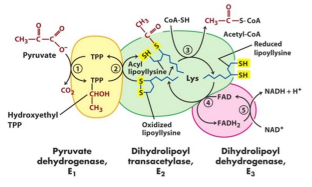PDC And KREBS (Tca)
Pyruvate Dehydrogenase Complex (PDC)
The PDC turns pyruvate into acetyl-CoA (generated from Glycolysis), NADH, and CO2. It is built from three different enzymes (E1, E2, and E3). This first step in this process is irreversible.
Enzymes
- E1: Pyruvate dehydrogenase
- E2: Dihydrolipoyl transacetylase
- E3: Dihydrolipoyl dehydrogenase
Cofactors for the PDC
- Thiamine pyrophosphate (TPP), derived from thiamine
- Flavin Adenine Dinucleotide (FAD), derived from riboflavin
- Coenzyme A (CoA), derived from pathothenic acid
- NAD+, derived from niacin
- Lipoic acid (produced by humans)
Steps

1: Pyruvate releases CO2 (decarboxylation) via E1
High energy and irreversible, this step drives the remaining 4 steps forward. The decarboxylation produces a negative charge which reduces the remaining 2-carbon molecule from ketone to alcohol.
Note: When gas is released, it diffuses out of the tissue and increases the entropy of the forward reaction. Thus, reactions which release gas tend to be more forward-favorable.
2: Alcohol on the hydroxyethyl reduces lipoic acid's disulfide bond via E1
3: Acetyl is transferred to CoA, forming acetyl-CoA via E2
OUTPUT: Acetyl-CoA is passed to the ETC.
4: Lipoic acid reduces FAD to FADH2 via E3
5: FADH2 transfers electrons to NAD+, forming NADH via E3
OUTPUT: NADH is passed to the ETC, resulting in 2.5 ATP.
Regulation of the PDC
High concentrations of NADH and acetyl-CoA will drive the last four reactions backwards. Additionally, pyruvate dehydrogenase kinase (PDK) is activated by NADH/acetyl-CoA. PDK will phosphorylate E1, inactivating it.
Clinical Pearls for the PDC
All of the following disorders have decreased PDC activity. Neural symptoms will result from the inefficient conversion of pyruvate to acetyl-CoA. For these cases, there will be a buildup for pyruvate in the mitochondria/cytosol and will lead to more lactate. However, the total ratio of pyruvate to lactate will remain the same.
Wernicke Encephalopathy
Associated with chronic alcohol abuse.
Symptoms:
- Ocular abnormalities
- Ataxia
- General confusion
Beriberi
Results from deficiency in Thiamine pyrophosphate (TPP).
Symptoms:
- Fatigue
- Irritability
- Sleep disturbance
- Abdominal pain
- Anorexia
Pyruvate Dehydrogenase Complex Deficiency
Manifests in infancy or later childhood. Patient will have a high blood lactate and normal pyruvate/lactate ratio.
Symptoms:
- Intermittent ataxia
- Poor muscle tone
- Abnormal eye movements
- Seizure
Krebs (TCA) cycle
This will take the acetyl-CoA from the PDC and make energy with it. The rate acetyl-CoA can be used depends on the availability of TCA intermediates (e.g., oxaloacetate).
Carbons: 66544444
Six, six, five, and five fours
Steps
1 . Citrate (6C)
Formed from acetyl-CoA (2C) and oxaloacetate (4C). This step is irreversible.
2. Isocitrate (6C)
The energy for this step (thioester hydrolysis) is provided by the previous reaction in 1.
3. Alpha-ketoglutarate (5C)
This is the first oxidation step, releasing CO2 gas containing the lost carbon. This is irreversible.
4. Succinyl-CoA (4C)
Highly similar to PDC, also releases CO2 gas. This step is regulated by product inhibition (build up of succinyl-CoA/NADH). This is irreversible.
5. Succinate (4C)
Although a thioester bond is hydrolyzed like the second step, its work is conserved in production of GTP.
6. Fumarate (4C)
This is complex II of the ETC (reduction of FAD to FADH2). Formation of alkene double bond.
7. Malate (4C)
Hydration of alkene double bond.
8. Oxaloacetate (4C)
Oxidation step. Although the free energy of this reaction is not favorable (dG = 29.7 kJ/mol), the small amount of OAA available is a strong driver of the reaction to the right under normal conditions.
Final products:
- 3 NADH
- 1 FADH2
- 1 GTP
- 2 CO2